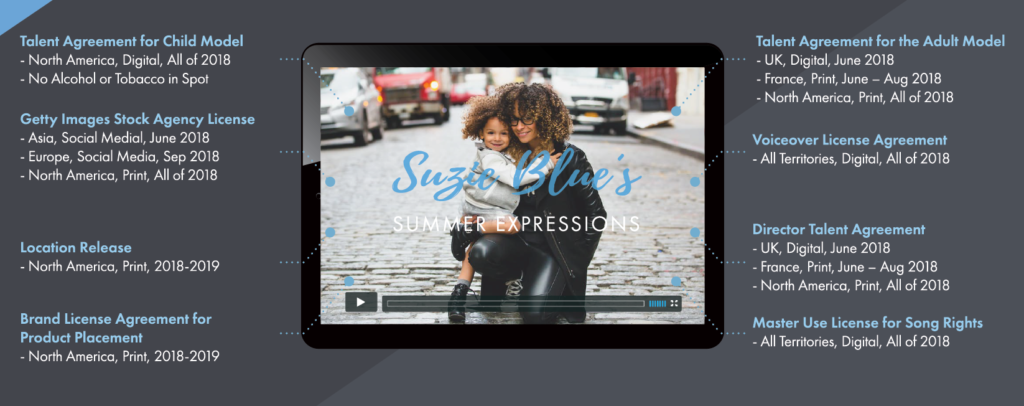
The “Rights” Way to Content Creation

Knowing your asset rights
As a creative team, the objective of your work is to best represent and promote your company, brand, or product through exceptional creative content. The content you create is aimed at reaching your audience and engaging them in a meaningful exchange of ideas and thoughts.
To execute such a powerful campaign, however, it’s essential to have a firm grasp on your asset rights. Without getting to “know your rights”, your company or brand becomes vulnerable to risk of non-compliance and violations- both of which can severely damage a reputation.
What makes digital asset rights so complicated?
Content usage rights are different for every asset. Think about an advertisement, for example- how many different assets are utilized to create it? There may be photographs, music, videos, models, actors, and photographers- all of which come with their own contractual agreements, and the stipulations may even change during the lifecycle of production.

Assets are complicated, especially when thinking about all of the usage rights associated with them. A photo comes with the individual rights and usages for the talent used to create it, but also for its distribution! Limitations on when, where, how, and for how long exist. A photo may be restricted to a specific region for a three-month period of time or it could be acceptable for international campaigns for a year.
Now consider this: you’re using that photo or ad across different channels- without proper management, it’s near impossible to distribute your content safely.
Can images be used without permission?
Let’s talk downloads. They’re safe, right? The short answer- NO. Just because an asset can be easily downloaded from a website, is an image from the internet, shared drive, or company Digital Asset Management (DAM) system does not make it legal to use. If you don’t own it, you shouldn’t use it.
Large marketing firms often have governance policies for checking asset terms of use, either done manually or automatically with Digital Rights Management software. Manually checking can be a tedious process and more often than not requires reaching out to legal, reviewing many contracts or cross-checking spreadsheets- all of which can be prone to human error or long processing times. Some companies will lock down assets based on rights or users, but many require creative teams to be accountable for the validity of their work.
Why Should I Review Digital Rights Management (DRM) pre-creative?
The longer you wait to do the homework, the more costly it can be for your brand. If something goes wrong, your creative team jeopardizes the integrity of your image and can cost you time and money.
During a recent brand management webinar, FADEL took a poll across attendees about their visibility into asset usage rights to find that only 31% were confident in knowing the rights and legal terms of their digital assets!
The key concerns to stalling a rights check, or not knowing usage rights are:
- Brand Image & Compliance – Misuse can cost millions in penalties–not to mention firefighting and rework. Plus, the negative press associated with a lawsuit can also lead to financial loss, for both the brand and the advertising agency.
- Delays in Distribution- Having to peruse complex documents or track down content rights can cause costly stalls in production. The need to cross-reference between departments, for example marketing and legal, takes time and occupies resources. This can delay the time to profitability for a product, wreaking havoc on balance sheets.
- Underutilized Assets- Lack of visibility into creative inventory prohibits many advertisers from getting the most out of their investments. Many advertisers cannot clearly see what they own or, if they can, are unsure whether they can reuse it without violating their contract. To optimally monetize content, it should be available across departments and rights should be available real-time, on-demand.
Let’s Get Creative, the Rights Way
To simplify rights even further, FADEL’s Rights Cloud has partnered with CI HUB Connector for Adobe Creative Cloud to give creatives direct DRM access within the Adobe tools your team is using. The integration enables creatives to:
- Connect any data source (stock sites, shared drives, storage sites, DAMS, etc)
- Find desired assets
- Check asset rights against the distribution plan
The connector immediately tells you if and when, where and how assets can be used. The best part? All of the information you need is at your fingertips, without having to leave the tool!
As a creative, you no longer have to figure out the contractual terms of an agreement or spend time sifting through contracts or contacting legal to do the dirty work. The powerful combination of Rights Cloud and CI Hub will automatically display asset usage rights within any Adobe Creative Cloud tool you’re working in.
Don’t Have a DRM Solution?
If you don’t already have a digital rights management (DRM) solution, check out the our how-to on implementing the ‘rights’ strategy for your needs!










